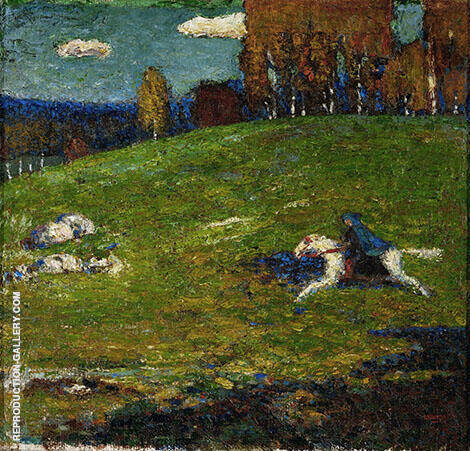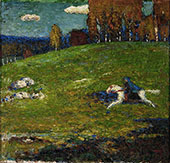The Blue Rider 1903 By Wassily Kandinsky
Wassily Kandinsky painted The Blue Rider in 1903. It is a foundational creation of European Expressionist and Abstract art.
Kandinsky's early life and paintings?
Born in Moscow (Russia), Russian artist Kandinsky spent much of his childhood in Odesa (part of present-day Ukraine). As a major seaport and trading hub, Odesa was a bastion of art and culture known as the “Pearl by the Sea.”
Kandinsky attended the Grekov Odessa Art School but only began painting at the age of thirty. Kandinsky was transfixed by the beauty of Monet’s Haystacks series and moved to Munich to commence his artistic career.
The Blue Rider (or Der Blaue Reiter) is one of Kandinsky’s earlier paintings. Despite this, it represents many of the artistic concerns that dominated Wassily Kandinsky's artwork thereafter.
In the artwork, the paint is thickly applied with stippled brushwork. Whilst green is the overriding color, vivid blues and shocking white interrupt the otherwise serene scene. The leaves on the trees are turning yellow, brown, and auburn with the changing seasons.
The horse and rider charge across the hillside with unparalleled speed, the stippled brushwork enhancing the impression of blurred movement.
What Does The Blue Rider painting represent?
The Blue Rider literally represents a horseman galloping at speed through a verdant green meadow. He rides a white horse (wearing a blue cloak) and passes through a forest.
Unusually (for one of the most famous abstract oil paintings of all time), critics comment the painterly skill is reasonably unremarkable. What sets it apart, however, is how the painting represents Kandinsky’s shift away from popular impressionism toward modern abstract art.
Kandinsky's abstract art was full of symbolism. The color blue was particularly important to both Wassily Kandinsky and his artist friend, Franz Marc.
Both painters believed blue enabled people to get closer to spiritual and intellectual concerns. The darker the shade of blue, the more it linked humanity with the eternal.
This sense of moving toward spirituality and truth is evident in The Blue Rider. The figure and their horse almost glide inexorably toward the deep, dark, blue horizon.
Whilst The Blue Rider remains figurative, it pre-empted later abstract art, such as Kandinsky's Several Circles (1926). In paintings such as this, Kandinsky focused on simple forms (the circle) to focus purely on color, composition, and the unity of opposites.
Created later in Kandinsky’s career, the painting is abstract in its truest sense. There are infinite possibilities for creative interpretation, generating a sense of spiritual and emotional harmony for the observer. The circles overlap and change color on a black background, with their random alignment belying deep purposefulness.
Who Started the Blue Rider Movement?
Of course, Kandinsky’s Blue Rider painting shares a name with the iconic artist's group.
Started by Kandinsky and other leading artists, Der Blaue Reiter movement rejected the more formal approach of the “Neue Künstlervereinigung München”. Other members included artists and intellectuals such as Marianne von Werefkin, Alexej von Jawlensky, August Macke, Paul Klee, Franz Marc, and Gabriele Münter.
Lasting from 1911 to 1914, Der Blaue Reiter art was fundamental to the development of German Expressionism.
It’s unclear whether the movement is actually named after The Blue Rider art by Wassily Kandinsky, however. Indeed, Kandinsky later said the name simply came from Franz Marc’s love for horses, his own love for riding, and the two artists' combined love for the color blue.
Nonetheless, the movement organized exhibitions all over Germany. They also published an almanac spotlighting contemporary, primitive, folk art and even paintings by children.
Sadly short-lived; their activities ceased with the First World War. Both Franz Marc and August Macke died in the fighting. The group’s Russian members (including Kandinsky) moved back to Russia.
After the war, Kandinsky formed Die Blaue Vier (The Blue Four) in 1923. This group maintained The Blue Rider’s expressionism and abstract focus, touring America from 1924 onwards.
Buy abstract art reproduction paintings and enjoy viewing our Wassily Kandinsky famous paintings.
We offer a 100% money back guarantee or replacement service. If for any reason you are dissatisfied with your painting please contact us within 7 days of receipt, advising the reason you are unhappy and we will provide you with all the information you need for its return or replacement.
We ship free to anywhere in the world via FedEx or DHL expedited service with online tracking.
Your painting will be shipped rolled in strong plastic tubing, ready for stretching and/or framing locally. This is the conventional method of transporting hand-painted oil on canvas. Learn more about how your painting is shipped.
We are able to offer a framing service intercontinental U.S. Please contact us if you would like a quotation. Alternatively, should you prefer, we can recommend a framer in your area.
Notes About Your Painting
Please note that replica oil paintings are finished with an additional 10cm (4") of extra canvas on all sides, allowing ample surplus canvas for stretching and framing.
Recently Viewed:
Cannot Find What You Are Looking For?
Reproduction Gallery Information
Customer Service
(Send Us A Message)
Tel: (503) 937 2010
Fax: (503) 937 2011







